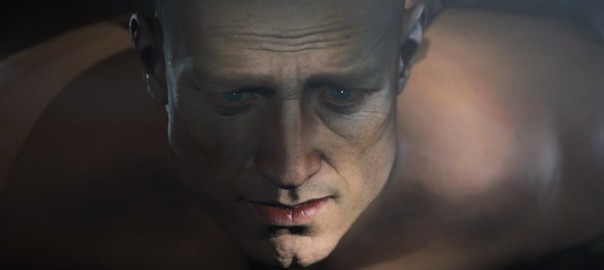Wolfenstein: The New Order, developed by MachineGames and published by Bethesda, should have been awful. If you’d asked me before release, I’d have predicted that the ninth game in a franchise, an alternate-history game set in the 1960s where the Nazis won World War II, featuring B.J. Blazkowicz as a recovered locked-in veteran, would only be good for a few hot takes and maybe some mediocre shooting with nose firmly held.
Instead, this game is one of the best I’ve played. It’s not just great, it’s well-crafted. That is to say that, beyond the things that appeal to my personal preferences (alternate history, cool sci-fi, a diverse cast, a dark tone, a considered pace) it shows great skill in how it executes what it sets out to do.
The credit for this success belongs to various factors—the expressive visual art, the excellent voice acting, and the well-polished rule systems—but more than anything, it’s thanks to the excellent writing.
The Main Timeline
When we talk about good writing in video games, we usually mean something different than when we talk about it in prose. “Good writing” in games typically means that the sequence of events in the game are interesting when summarized. Well-written prose, however, might have totally mundane events; it is the way in which they are communicated that distinguishes the quality of the writing.
Video games are obsessed with high concept. A clear and literal threat exists, usually threatening all of society. A hero is uniquely equipped to defeat that threat. In the end the threat is defeated. Stories are usually distinguished by an interesting setting and by the “twists” that happen along the way. Let’s look at Bioshock Infinite, a game which received numerous “Best Story” awards in 20131.
Infinite is lauded for its interesting setting: a city above the clouds tainted by American nationalism and racism. It’s got a charming naif in the form of Elizabeth. And it has a complex twisty storyline involving parallel worlds and surprise identities. But on a low level, the writing is functional but unremarkable. Consider this scene, from the ending to the game:
That’s decent for video game writing. Still, it’s full of “profound” writing that sounds cool but doesn’t actually communicate much or scan well as interesting prose. The rhythm of conversation is formal and unconvincing. “Constants…” “And variables.” It reads like characters following cues, not having an actual exchange of ideas. “We swim on different oceans but land on the same shore” is serviceable: the characters from different worlds all end up at the same climactic event. But as a metaphor that evokes little. What does it look like to land on the same shore from two different oceans? What does it say about the situation that would not be better communicated with literal language?
This scene was written in service of communicating the Big Idea of the game, preparing players to understand how parallel worlds work in this setting so that the Dramatic Ending makes sense. But as a scene featuring characters in a credible world, it falls flat. What are Elizabeth and Booker feeling in this scene, beyond “wonder” and “bafflement?” How does this inform their moral or emotional journey or their relationship as more-or-less-surrogate family?
This is the problem with video game writing. It’s seen as a tool to deliver the plot beats instead of as an integral aspect of the art. As long as we evaluate game story by what happens in the plot rather than how it’s communicated, we’re missing the point.
Point of Divergence
The events that happen in The New Order read like a mildly original action game. You’re fighting a Nazi supervillain during World War 2, get injured, and are put into a coma for sixteen years. When you wake up, the Nazis rule the world. You revitalize the resistance, steal Nazi technology, visit the moon, and ultimately confront the supervillain in the same base where you originally failed.
When seen as a sequence of events, this story is unremarkable. Consider some details and you may find it concerning: a powerful, secret Jewish society; a level set in a Nazi work camp; mentally and physically disabled characters in a setting that constantly reminds you of Nazi ideologies. However, through careful writing these concerns can be alleviated.
Compare the following segment from The New Order to the one above:
In this scene, even if you haven’t seen the earlier exposition, you understand who these characters are, what their relationships are, and how they feel about the situation as the larger plot is moved forward. Caroline is a leader, stern and no-nonsense, who deals with pain through abrasiveness and open confrontation, but who is willing to change tactics when she has made a mistake. B.J. is brash and friendly, but with a tone of resigned sadness; he functions best when operating under orders but has trouble dealing with unfamiliar situations (although injury and disability are not unfamiliar to him). Caroline and B.J. know each other from long ago, but this is their first time meeting since their respective injuries. Anya is quiet, unassuming, and very smart; she wants to help people and is good at expressing herself without offense. Tekla reacts to strong emotion by lashing out and is entirely uninterested in courtesy, but her agitation suggests that she does care, at least about Fergus’s survival.
I realized while playing The New Order that when I play high-budget games, I’m often on constant edge, bracing myself for the game to do or say something disappointing. It’s a consequence of my being enthusiastic of both positive representation and game design technique. In the back of my head I’m always worrying that the game will, in a cutscene, arbitrarily kill a woman or make me hate my player character.
But by consistently treating its characters with respect and showing a capacity for purposeful and nuanced plotting, The New Order let me relax and accept the sometimes-silly story and well-crafted combat without getting distracted by worries about what would happen.
Alternate Choices
So what’s different about The New Order that it was written so well? Was the writer just great? That’s part of it. Jens Matthies was the creative director of the game. He previously worked on The Darkness and Chronicles of Riddick: Escape from Butcher Bay, both games noted for their surprisingly well-handled characterization. In an interview with Giant Bomb, he makes it clear that they considered things like how to represent an action hero with depth, or how to address Nazi ideology without trivializing it or turning it into a cartoon. Matthies and the rest of the game’s team were clearly well-equipped to handle the creative process well.
But that doesn’t mean that other games’ writers and directors are poor at their jobs. Part of the reason that The New Order is able to showcase the skill of its creators is that the development process placed story and character in a high-priority position. Time and effort and attention (and money!) were spent on writing, rewriting, acting, and presentation. Too many games clearly focus overmuch on “fun” and established conventions without considering that those things are successful only when supported by a well-crafted aesthetic framework.
To make a game with story as well-handled as The New Order‘s, you must make it a priority from the beginning. You can’t design a bunch of fun levels and then mortar them together with a post facto plot. You must make your story grow and mature beside the rest of the game and be willing to prioritize nuance and consistency of presentation.
I never would have suspected that Wolfenstein: The New Order would be one of the best-written games I’ve ever played. But it was. And it is something that we can all aspire to.
This article was made possible in part through the Patreon donation program. To support my work, sign up for my Patreon and help me continue producing writing like this.

